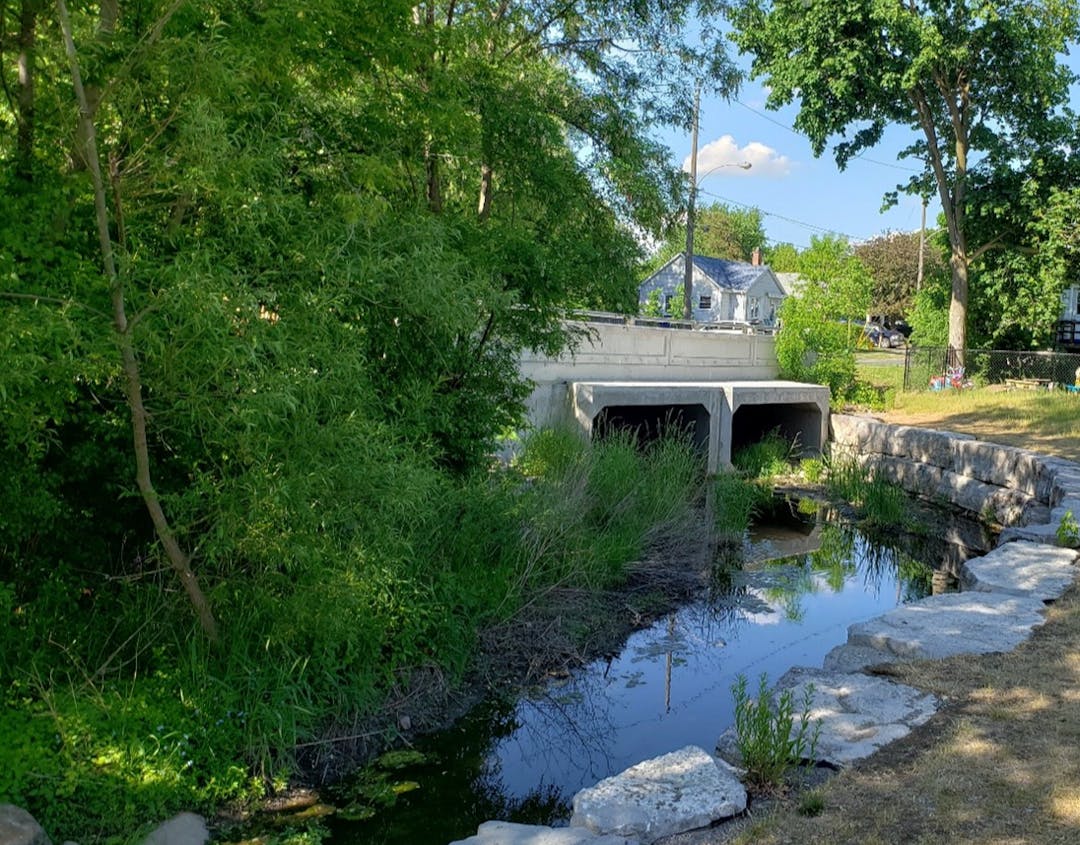Curtis Creek Channel Improvements

Project overview
The proposed project includes a review of the entire natural channel system throughout Curtis Creek from the Trent Canal to Tivey Street. Flood reduction and natural channel improvements will be designed where measurable flood reduction and channel erosion control benefits can be implemented. Curtis Creek through the project area traverses through a number of private residential lots and public lands.
The proposed works have been designed to reduce flooding by modifying portions of the channel and providing an appropriate low flow channel throughout the system. Flooding occurs when stream flows present a hazard by coming in contact with private or publicly owned buildings and infrastructure. It should be noted that while the proposed works will significantly reduce flooding during the majority of rainfall events, overflowing of stream banks will still occur during intense storms.
The recommended works will incorporate the principles of natural channel design by better utilizing floodplain storage on public land, and natural channel forms and functions, where possible. This will reduce the depth of flooding and improving the efficiency of the newly replaced culverts.
Natural material and softer engineering approaches will be used to restore modified channel and floodplain areas. This may include riparian zone plantings, vegetated stone revetments, live staking or brush layering. There will be limited use of hard engineering methods (i.e. armourstone walls). The softer engineering methods will provide for reduce bank and soil erosion while also providing an overall improvement on fish habitat, improved ecological quality to the watercourse.
Consultation
How can you be heard?
As part the project process, we are collecting feedback from the community to ensure the project is meeting the community's needs. We encourage you to provide your feedback and ask any questions you may have through the Questions and Comments section found at the bottom of this page. Your feedback is valuable in ensuring the proposed Curtis Creek Channel improvement project meets the needs of the community. We value your feedback and we will review and consider all input we receive. Please note that changes to the project based on community input will only be made where deemed feasible by the project team.
This page presents conceptual designs to the public and to receive feedback from the interested stakeholders and landowners throughout the study area prior to advancing to developing detailed design plans. No construction works will be completed until necessary feedback and permissions are received from private and public landowners
All impacted residents will be consulted on an individual basis as designs are finalized. Several parties have already been approached as part of the ongoing works including the following:
- Local residents
- Curve Lake First Nation
- Hiawatha First Nation
- Otonabee Region Conservation Authority.
The sites
The project has been divided into four (4) separate sites and their proposed works are described below:
Site 1: Upstream and Downstream of Armour Road Culvert
Proposed works:
- Reinforce toe of stone lined wall along 617 Armour Road by placing additional stone with plantings
- Minor channel regrading to increase conveyance capacity of watercourse between 607 and 617 Armour Road
- Removal of armourstone upstream (east) of Armour Road to increase conveyance capacity and improve fish habitat by incorporating a vegetated boulder revetment
Site 2: Upstream and Downstream of Caddy Street Culvert Crossing
Proposed works:
- Removal of armourstone wall downstream (south) of Caddy Street and replacing with vegetated boulder revetment to provide greener bank treatment and to increase conveyance capacity of the watercourse and culvert
- Minor channel regrading to increase conveyance capacity of watercourse both upstream (north) and downstream (south) of Caddy Street
- Removal of berm and lowering of existing manhole to provide improved floodplain access
Site 3: Downstream of Euclid Avenue
Proposed works:
- Remove armourstone wall downstream (south) of Euclid Avenue and realign watercourse to improve the hydraulic efficiency of the new curvet and better utilize flood storage in the park
- Take advantage of the channel realignment to build sidewalk along southern edge of Euclid Avenue and provide public access to the area.
- Restore newly aligned channel with vegetated boulder revetment to provide greener bank treatment and improve aquatic habitat
- Construct pocket wetland at storm sewer outfall location to enhance water quality treatment of storm sewer discharge
Site 4: Slope Stabilization
Site 4 involves making improvements to the slopes in the area of the creek.
Two (2) design alternatives have been presented to stabilize the valley lands, both include reinforcing the valley lands using both soft and hard engineering principles:
- Concept 1: Terraslope Reinforced Slope – via geogrid and vegetated valley lands
- Concept 2: Retaining wall and gradual slope along the top of lands
The ultimate decision will be based on consultation with the private landowners, First Nations and interested stakeholders.
Next steps
All input and feedback will be reviewed and considered by the project team, and incorporated into the detailed design if possible. All future project progress updates will also be posted to this page, including project timing and construction schedule.


